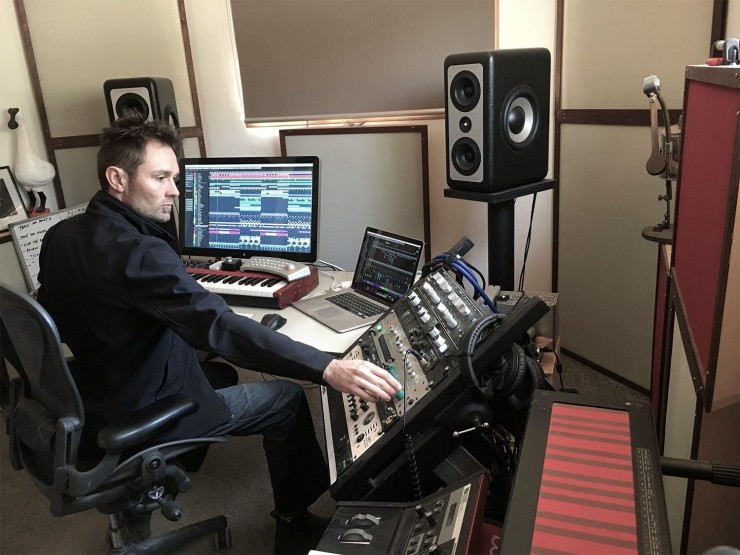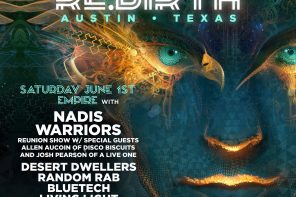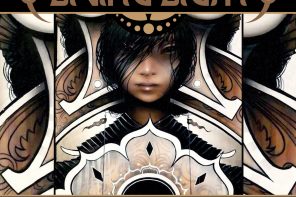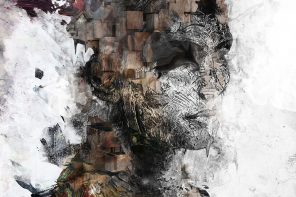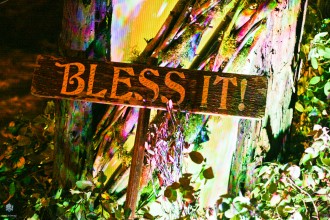The Spoonbill – Native to South Eastern Australia, this particular sub-species is found residing in bushy areas, away from the urban sprawl. Like most birds Spoonbill has crafted his nest using material sourced from the earth around him. Next to this nest, in between that and an old Tram that once roamed the streets of Melbourne, we find the incubator. A space to nurture and work on his little beatlings until they are fully grown and ready to be released on to the wild dancefloors that he frequents. I had the pleasure of visiting this impressive nest, jumping into the incubator and digging a bit deeper into the psyche of this great Australian creature.
[LIS] Let me paint a picture – It’s Strawberry Fields Festival, transitioning into Saturday night. Austero is rocking out on his guitar over some slammin’ tunes and the vibes are high, when this big insect car rolls into the middle of the dancefloor. You pop up on the top of it and proceed to smash the dancefloor for the next hour and a half. Were you involved in the construction of that art car?
[SPOONBILL] I was actually. It’s name is UKI – Utility Kinetic Insect. A good friend and long time collaborator Callan Morgan and I conceptualized the idea of making an animatronic mobile art car/stage about five years ago. We followed through and started getting our hands dirty with it last year. We initially planned to make a giant praying mantis, but we ended up acquiring a donor vehicle and stripped it down completely to the chassis. We took the engine out but left the gear box and the rest of the running gear in it, procured a 1960’s 3 tonne electric forklift engine and coupled that to the existing gearbox. It has 18 deep cycle batteries mounted to it, 1.2 tonne of batteries. It’s a beast of a thing, a completely electric vehicle, silent with no emissions. On top of that we built a system with 25 actuators, which also run off batteries and can push/pull to control the movement of the legs and wings of the insect – it’s all synced with the lighting effects and sound design. It’s a pretty epic animatronic art installation/car/crazy high torque, low range 4 wheel drive.
Yeah, I studied Industrial design at Uni and exhibited a bunch of furniture in different places around the world such as Tokyo Designers Block, The Melbourne Museum and The Powerhouse Museum in Sydney. I’ve done a bunch of installations kind of similar to UKI and exhibited them at a wide range of places, including 100% design in London. All that stuff is a useful knowledge base to draw on when building a mutant art car, and also when building this house and studio. Even in the way I make electronic music, the skill set is sort of similar. Industrial design is a marriage between art and science…. I actually designed the chair your sitting on.
After finishing at Uni, I set up a company with a good friend who I’ve since worked with for a long time doing Audio Visual shows: Dropbear. We started a company called Brainstorm Interactive doing graph style T-shirts when we were about 18, and later started a design consultancy called Stembase. We ran that for about 5 or 6 years, but during that entire time I never stopped making music.
How did that start?
I started composing electronic music on the computer in about 2000. But before that, around 1998, I bought my first sampler which was an SP-808. I initially made music with that thing, but it was more sampling art than conventional electronic music. I recorded myself and my friends playing different instruments and proceeded to chop it up/compose it live with the SP 808. Then I bought a hardware sequencer and started playing gigs with a sampler and a sequencer at different clubs and venues. In 2000 I started composing on the computer with Nuendo, which is basically Cubase, which is the DAW I still use now.
What is the inspiration behind your sound?
Well I was influenced by a lot of the instrumental hip hop and trip hop sounds that were around at the time. Particularly Ninja Tune – people like Amon Tobin, DJ Food, Coldcut and a lot of the big beat breakbeat stuff that was around at the time. They were a big influence, but one thing I noted about all that music was that their sampling was referencing the culture that they were from which was either the U.S. or the U.K., particularly with their vocal sampling. So when it came to composing music, I started experimenting with sampling Australiana, sampling people like Bush Tucker Man, Mem Fox and all the quintessential Australian icons. Plus things like random AM talkback radio and old grandmas chatting about random jibber-jabber, and then splicing those colloquial Australian audio grabs into my composition which was really the start of the Spoonbill sound.
For a few years I composed music purely for my own enjoyment, and I had never really thought about releasing an album. After encouragement from a bunch of pro muso mates, I though what the hell…. And booked a mastering session a few months in advance to set myself a deadline. Initially I didn’t really know what to expect from releasing an album, but ultimately I was stoked by the way people latched on to it. It was definitely something unique compared to what was around at the time.
Fair play to you, because the earlier stuff and the most recent stuff still sounds like Spoonbill. The sound has progressed a lot, but you have stayed true to your sound the whole time.
I suppose it’s my aesthetic – my prerequisite is to make music I want to hear. Of course I’ve been influenced by different styles and different scenes and also playing so many gigs around the world for so long. All that stuff slowly takes affect through osmosis and influences you, even if you’re not aware. But still I think fundamentally my aesthetic with music is the same; I just like quirky funky stuff. I’ve always been true to what I want to hear, and I think people can hear that in my music. It definitely hasn’t been an exponential curve to success, but more of a very slow and steady trajectory as a career. I’m completely happy with that and believe it’s much healthier and sustainable.
Your sound was so unique at the time – how did you find a place for yourself, especially around Melbourne?
It was quite interesting because I was playing at a place called Loop Bar in Melbourne quite regularly. I had 2 monthly residencies there and also my brother had a bar called 303 in Northcote, so I played there a lot, as well as the odd gigs around town at other bars and clubs. After I released my first album, I went to Burning Man in 2005 and as my gift I burned around 200 copies of the album, hand signed each one, and handed them out to random people.
Camping next to us that week was this guy Bosque. I walked over to their camp and said “Hey guys, here, have a CD,” and he immediately put it on through the sound system in their bus. After a few minutes of listening, he was super excited and turned around and asked, “Do you want to play at my festival in like two weeks?” So I said, “Sure, alright,” and that was the first Symbiosis Gathering. I also gave one to this guy Sol Brown as well, who turned out to be one of the guys who orchestrated the winter solstice festivals up in Cairns, QLD, which were a real institution in the psychedelic scene (awesome parties that went on for about 8 years.) Little did I know that I had given my CD to two incredibly influential people running major outdoor events, one in California and one in Australia, and they were both instantly stoked on the music.
How was Symbiosis?
I rocked up to play the Symbiosis Gathering two weeks later and was informed that Bluetech had cancelled his set. I had never even heard of him at the time, but I had been told I would be playing during his time slot. I arrived and the crowd was pretty full because everyone was expecting Bluetech, but I started serving up this wonky Australian music instead. Everyone was like “What is this!?” It was a good step up for me, but it was a step up inside of the psychedelic music scene which was not at all where I expected to be, coming from more of a hip hop and breakbeat background. When I arrived back in Australia, I was offered a headlining slot at the Solstice psytrance party and thought that was a bit strange, but who was I to say no. For about 3 or 4 years, I was regularly booked to play at trance festivals around Australia and I was pretty much the only act that wasn’t trace or 4 on the floor.
How did people react?
All things considered, people reacted pretty positively. Especially because back then my music wasn’t as danceable. There were no obvious drops, and it was much more tangential.

It can be quite odd to go from uptempo vibes to mid-tempo weird, wonky stuff.
Yeah, over the years I’ve encountered some people who don’t realize I’m playing all of my own material, and they shout things like “Play something faster!” I’ve actually had a lot of people come up to me (especially in the U.S) while playing some of my squiggly, wobbly tracks and say, “Yeah, I love this track, this is one of my favorite Tipper tracks!” I’ll be like, “Nah this is my track,” and they will try and argue the point with me.
That’s pretty funny. On the Tipper note, lets chat Omelette Records. What’s the story there?
Omelette was originally the audio/visual duo of Dropbear and I. We were performing under the name Omelette for a year or two, but eventually we changed our names and Omelette became the record label. It originally started because I had no idea where my music fit inside the landscape of labels. I didn’t know much about the music industry, but I knew I could start my own label so I did just that.
I presume you were dealing with physical copies of CD’s rather than digital.
All physical copies. I distributed through Creative Vibes who represented the likes of Ninja Tune and Warp Records. I sent them my first album not really expecting that anything would happen, and I called them up a week later and the head of the company was like “Oh it’s the Gumtree man!” – he was super into it. He actually thought it was going to be a much bigger hit than it was. They issued all of this press and publicity, labeling it as Australia’s answer to Mr. Scruff (which I was stoked about because I thought Scruff was cool). It was sent off to Triple J, the largest radio station in Australia, but they never picked it up. In fact, their response to my submission was,
We do not condone larrikin music.
Larrikin (Australian) – A person with apparent disregard for convention; A maverick. (Oxford Dictionary)
This totally missed the point of what I was trying to do with the music and the Australiana sampled in my music being tongue in cheek, but in hindsight I’m glad with the way it panned out.
So Omelette was started as a vehicle for my own releases, but then I had a bunch of like-minded crew who were looking for an avenue to release their stuff and so we decided to start a collective. The idea was that you would get cross promotion by being associated with other artists, but it’s run like your own label, where each artist sub manages themselves and self-funds their releases but in return keeps 100% of the profits. It has been that way up until quite recently, when we received some external help for management duties.
How did you became friends with Tipper?
It was 2006 when I met him at the second Symbiosis Gathering. Bosque called me up and said, “I’ve given you a pretty decent slot among the headlining acts on the main stage Saturday night – you’re on between a guy called Ott. and a guy called Tipper.” I had never heard of either of them, so I thought I had better familiarize myself with their music. I looked them up online and came across Tipper’s Seamless Unspeakable Something and it totally blew my mind.
I performed after him at Symbiosis and remember that he was packing up as I was getting into my set, and he was really digging the tunes. Then I saw him again at Shambhala in Canada… His set on the beach was one of the best sets I’ve seen, I think it was shortly after Wobble Factor had been released. I went up to him after his set and told him. Then once I finished my third album Zoomorphic, I sent it to him to master and spoke with him about doing a proper tour of Australia. He thought it was a good idea, so he stayed with me for about a month at my place in Northcote. We got along really well and spent a bunch of time in my studio, where I was able to show him my music production process. He dug my studio/setup and at the end of that first OZ Tour, I took him shopping and he purchased a whole bunch of the same gear. I mentioned that I had built a store (Omelette), and that if he ever wanted make his releases available for sale, we could distribute through Australia for him.
I was introduced to both you and Tipper at the same time at Rainbow Serpent a few years ago. Seeing Opiuo, Tipper and yourself back to back blew my mind.
It’s so good to see that Tipper is now cranking in the U.S. He has always been well respected among people who know their stuff in electronic music, but he was never super massive until the last couple of years. Now he has just skyrocketed and it’s great to see. Couldn’t have happened to a better, more deserving bloke.
Your last full length album Tinkerbox is one of my personal favourites. Your Dad painted the album cover, and your brother played guitar on one of the tracks. You come from a pretty creative family, yeah?
Yeah, my brother also played guitar on one of the tracks on my recent Squawkus EP, as well as a bunch of earlier tracks of mine. Both of my parents are artists. My Dad was head of the print making department at RMIT University in Melbourne, but now he works as a full time artist and has done so for a long time. I recall when I finished my Uni course he said one of the most legendary things a parent could say to their creative child. I said, “Dad, I finished my course,” and he goes, “Oh yeah, well now that you’ve finished your course, you’re not going to go and get a job are you?” Not implying to go and slack off, my Dad has a wonderful work ethic as do I, but he was very encouraging when it came to creating my own path and not working for the man.
Can you elaborate on the story behind Tinkerbox?
I actually borrowed the concept from my Dad’s artwork. He did a series which was exhibited at Australian galleries earlier this year called The Tinker Van, which celebrates old tinkers. Tinkers were nomadic handyman type guys who would travel around rural areas with a various tools and travel from place to place, sharpening peoples knives and fixing things. Similar to traveling gypsies who fix things for cash. I’ve always been handy making stuff, and my Dad built our family home himself in rural Victoria. My grandfather, who also built his family homes, remembers the old tinker vans that would travel around rural Victoria. I was really intrigued by the whole concept of it and wanted to use some of my Dad’s artwork for my cover art, but rather than Tinker Van I called it Tinkerbox, alluding to the concept of fragments of sound woven together into the one sound collage that builds a composition. So there’s a few levels to the meaning of the it.
Awesome stuff. Thanks for taking the time to sit down.


